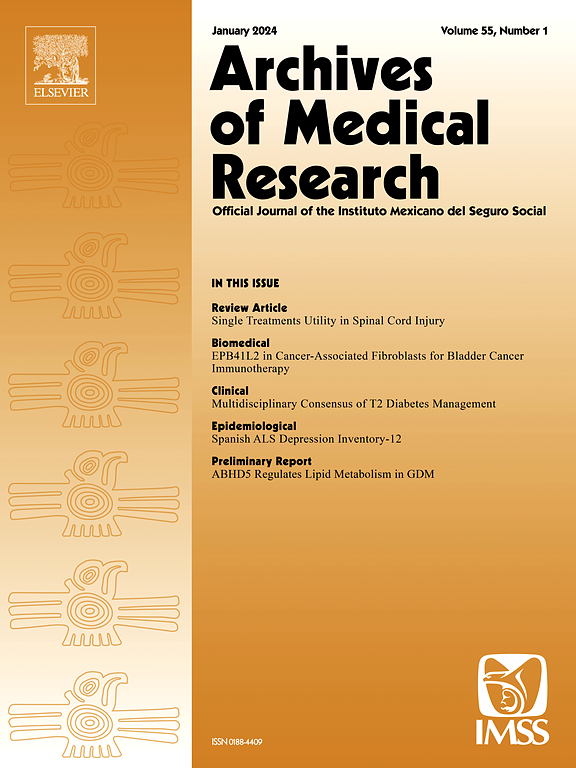人类射精中的双链 DNA 断裂与精子总 DNA 断裂之间存在密切联系。
IF 3.4
3区 医学
Q1 MEDICINE, RESEARCH & EXPERIMENTAL
引用次数: 0
摘要
背景:精子中的双链和单链DNA断裂(DSBs和SSBs)分别来自内在和外在的退化过程,可能与潜在的男性病理学有关。目的:确定人类射精中DSBs的发生率是否是整个精子DNA碎片(W-SDF = SSBs + DSBs)的一致预测指标:显示全W-SDF的精子比例与DNA中仅显示DSB的精子比例之间存在相关性。建立了两个患者群:结果:W-SDF ≤30%(低 SDF;n = 153)和 W-SDF ≥30%(高 SDF;n = 222):结果:W-SDF水平的增加与射精中DSB发生率的增加有关。将低 W-SDF 组和高 W-SDF 组的数据合并后,观察到一种线性关系,W-SDF 每增加一个单位,DSB 就增加 0.799 个单位。然而,如果对这两组数据分别进行分析,其关系则有所不同。在低 SDF 组,W-SDF 每增加一个单位,DSB 线性增加 0.559 个单位。而在高 SDF 组中,W-SDF 每增加一个单位,DSB 就以 0.602 个单位的指数形式增加。此外,两个变量之间的数据离散度在不同组别之间存在显著差异,高 SDF 组的变异性是低 SDF 组的 0.8 倍:结论:虽然精子中DSB的存在与原始精液样本中的W-SDF相关,但在DNA损伤水平较高的射精中,造成DSB的生物机制的表达比例和/或水平不同。本文章由计算机程序翻译,如有差异,请以英文原文为准。
Strong correlation between double-strand DNA Breaks and total sperm DNA fragmentation in the human ejaculate
Background
Double- and single-strand DNA breaks (DSBs and SSBs, respectively) in spermatozoa, which emerge from intrinsic and extrinsic degenerative processes, are likely related to the underlying male pathology.
Aim
To determine whether the incidence of DSBs in the human ejaculate is a consistent predictor of whole sperm DNA fragmentation (W-SDF = SSBs + DSBs).
Methods
A correlation between the proportion of spermatozoa that showed whole W-SDF and those displaying only DSBs in DNA. Two patient cohorts were established: W-SDF ≤30% (low SDF; n = 153) and W-SDF ≥30% (high SDF; n = 222).
Results
An increasing level of W-SDF is associated with an increased incidence of DSBs in the ejaculate. When data from both the low and high W-SDF groups were combined, a linear relationship was observed, with DSBs increasing by 0.799 units for each unit increase in W-SDF. However, when the cohorts were analyzed separately, the relationships differed. In the low SDF group, DSBs increased linearly by 0.559 units for each unit increase in W-SDF. In the high SDF group, DSBs increased exponentially by 0.602 units per unit of W-SDF. Furthermore, the data dispersion between the two variables was significantly different between the cohorts, with the high SDF group showing 0.8 times greater variability than the low SDF group.
Conclusions
While the presence of DSBs in sperm is correlated with the W-SDF present in raw semen samples, the biological mechanisms responsible for DSBs are expressed in different proportions and/or at different levels in ejaculates with higher levels of DNA damage.
求助全文
通过发布文献求助,成功后即可免费获取论文全文。
去求助
来源期刊

Archives of Medical Research
医学-医学:研究与实验
CiteScore
12.50
自引率
0.00%
发文量
84
审稿时长
28 days
期刊介绍:
Archives of Medical Research serves as a platform for publishing original peer-reviewed medical research, aiming to bridge gaps created by medical specialization. The journal covers three main categories - biomedical, clinical, and epidemiological contributions, along with review articles and preliminary communications. With an international scope, it presents the study of diseases from diverse perspectives, offering the medical community original investigations ranging from molecular biology to clinical epidemiology in a single publication.
 求助内容:
求助内容: 应助结果提醒方式:
应助结果提醒方式:


